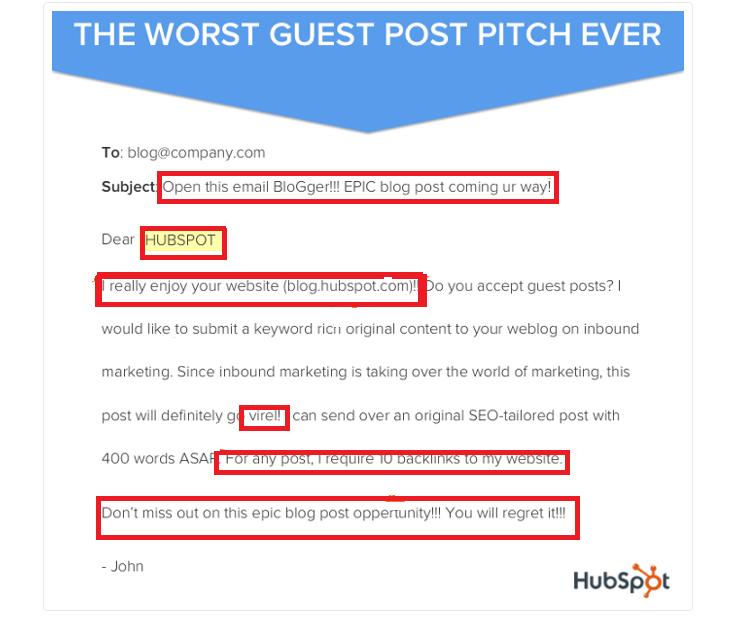
101 effective ways to increase your blog traffic (website traffic) fast in 2020
Whether you want to get traffic to a new blog or you are thinking about the best ways to add new traffic strategies in 2019, you will love to see a detailed list of the best website traffic options available today, in the current online marketing landscape. Because just as money is the blood of any business, traffic is the blood of online marketing.
[Tweet “”Just as money is the blood of any business, traffic is the blood of any online marketing strategy” – www.OliviaAngelescu.com”]
Getting traffic and leads is the top challenge online marketers are facing, as you can clearly see in the research below:
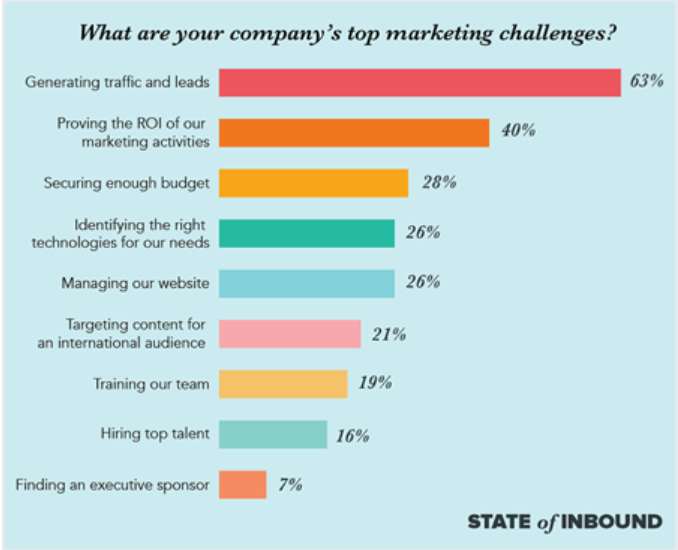
The bad news is that there was never so much competition over people’s attention online. Whenever we grab that tablet or open our laptop we are instantly bombarded by content and lead magnets and ads, there are so many options everywhere and we are asked to take all sorts of actions. This means one thing: things must be really good to get our attention.
In other words, any bloggers and marketers need to approach their traffic strategy with two things in mind:
- standing out from the crowd with authority and
- providing the best experience to their leads, from the first second those leads interact with their content.
Here are 101 great ways to do just that.
A. How to increase blog (website) traffic by using the content published on your own platforms
1. Choose the best topics to write about
Your content will get shared a lot only if it provides immense value for the readers. This means two things:
- Your topic should address a burning need of your targeted audience (whether this is teaching them how to do something or just providing lots of motivation or inspiration)
- Your content needs to be stellar, so try to write the best content that is written on this subject.
If you need some inspiration, here is a list of great blog post ideas for every niche. Remember that, to maximize your results, you should write evergreen content that will be relevant for a long time.
2. Pay attention to the length and format of your posts
According to BuzzSumo, long-form content (more than 3,000 words) gets the most shares.
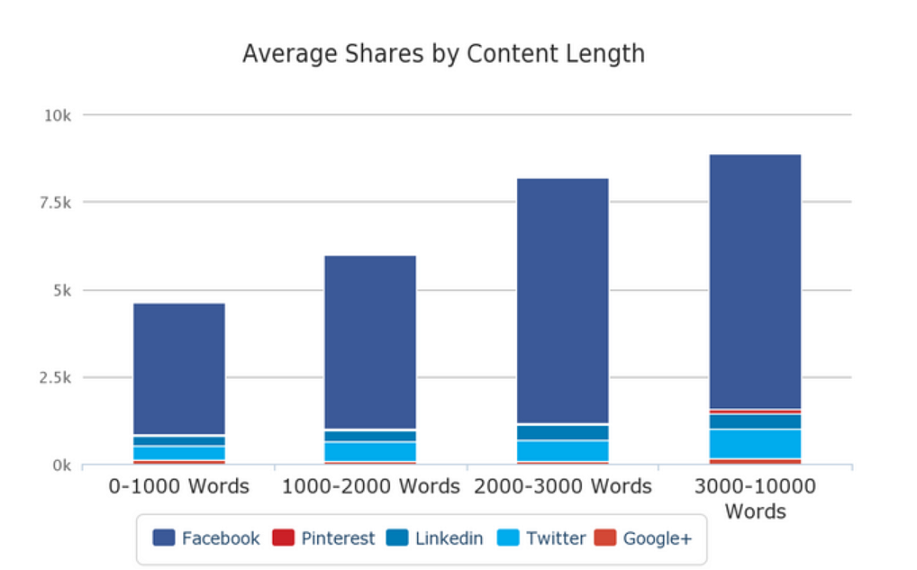
So short, fluffy, average value content no longer cuts it. Also, your content needs to be easy to read. Break up your content into paragraphs, use an easy-to-read font, subheadlines, bullet points and emphasize the main ideas with bolded text. In this way, you will optimize your article for both your readers and for SEO purposes. Needless to say that proofreading is a must; Grammarly is a great tool if you are not a native English speaker.
3. Write stellar headlines that grab people’s attention immediately
Without a great headline, your content will not get read and shared by most of your website visitors, which means your traffic will not increase. There are a lot of tools that can help you come up with engaging headlines, read about seven of them in this BloggingWizard article.
4. Invite others to write for your blog
By inviting other experts in your space to contribute articles to your blog, you take a lot of pressure off your shoulders (who said creating regular great content is like a walk in the park?), while allowing them to reach your audience. In exchange, ask them to share their guest post with their audience: a win-win situation!
5. Create the best content and include share buttons at the end (but no more than 3)
Make sure you make it very easy for people to share your content, by including social sharing buttons at the end of each article. Keep it at maximum three buttons, don’t give people a lot of actions to choose from. Otherwise, they will not take any.
6. Insert a CTA to share your article if they want to download a content upgrade
We already know content upgrades are a great way to build your email list. Once your readers sign up, offer them the option also to share the article if they want to access yet another content upgrade.
7. Add “click to tweet” widgets inside your posts
By embedding a simple tweet into your post, you will make it easy for your readers to share it quickly. Just like I did here (I am using a plugin called Click-To-Tweet by CoSchedule.
[Tweet “Adding click-to-tweet boxes to your content is a simple way to increase your website traffic.” – www.OliviaAngelescu.com”]
8. Update old content
When you have valuable articles that get the most traffic, make sure you update them to include the latest information and consider adding more information or visuals to make it even better. Google fresh and relevant content, so updates are necessary.
9. Repurpose your content to increase your reach
People learn differently: some are more visual, others prefer to read, while others prefer audio or video content. So it makes sense to repurpose your content, to reach as many of those people and make it easy for them to consume (and see the value in) it.
10. Use other’s viral content
Don’t be afraid to use puppy videos or another type of viral YouTube content to make a point about your own topic (you need to be able to tie the two of them in a natural way, of course). The video will attract a lot of attention to your blog post, which you can then gracefully redirect to the meat and potatoes.
11. Start a podcast
Launching a podcast in a great way to tap into a new audience that prefers to put their headphones on and consume information. The guys at Fizzle have a great resource on starting a successful podcast that increases both your traffic and your income, check it out here: Fizzle podcast article.
12. Host webinars
Hosting regular free webinars to share valuable information (with or without a sales pitch at the end) is a great way to increase your authority and your traffic. Also, webinar traffic is better quality traffic (ready to buy), so you can start promoting at the end of each webinar as soon as you have a product or service.
13. Self publish an ebook
There is a lot of content out there on how to self publish a Kindle book, here is one of the best: https://smartblogger.com/kindle-publishing/. And this is what Neil Patel did to increase his traffic with 206% (the first traffic strategy he mentions is Kindle traffic): https://neilpatel.com/blog/7-proven-strategies-to-increase-your-blogs-traffic-by-206/
14. Create visual content and add it to your posts (infographics, charts, images)
Visuals can be a great way to get additional traffic to your website. You can also allow people to use your images for their websites with the condition to cite you as a source. For bonus SEO points give those images names that include your keywords; this will ensure they appear in searches.
15. Use multimedia type of content to engage even more the readers (more engaged readers = more shares)
The same visual content above plus any video you can add to your blog posts will also engage the readers more, which will increase the number of shares.
16. Write reviews or case studies of how you used specific tools/software/courses/advice and share it with those people/brands
If you have a blog or an online business, you must use at least a few tools such as website platforms, email marketing solutions, landing pages software, design programs, apps, etc. Also, I bet you joined a few online courses so far or maybe just followed the advice of a top influencer and this got you nice results. Write an article about this, including what you did and your results and mentioned that tool or brand that was useful. Then share the article with those you mentioned. There is a big chance that they will share your article with their audience.
17. Publish content consistently
Put together a basic content calendar and stick to it. You should aim at publishing at least two pieces of content per month. You can plan your content on paper or use a spreadsheet or even something like Trello. I specifically loved to see how Suzi Whitford from Startamomblog.com used colorful post-its for her content calendar, as you can see below.
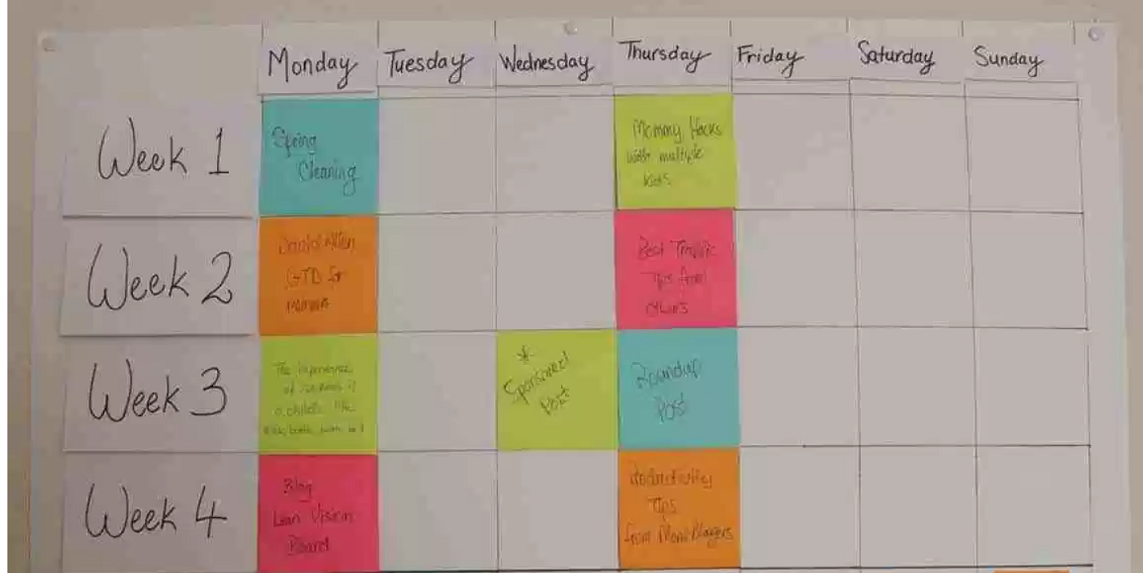
18. Repurpose your content
From your blog posts, you can create social media content and emails that you can easily schedule. Also, you can record a video out of one blog posts and use it for a webinar. In this way you can focus on creating the best content out there, knowing that you will get this time back afterward.
19. Syndicate your content – SlideShare
SlideShare is a presentation-sharing platform owned by Linkedin that gets more than 70 million visitors every month, so it makes a great platform to use as a traffic source. Here you can read a detailed case study on how Eugene Cheng used SlideShare to get 2 million website visitors.
20. Mix (formerly known as StumbleUpon)
Mix is a syndication platform that allows you to submit content (links) that the other users can then discover, based on their interests.
21. Host a virtual summit
By leveraging the combined marketing efforts of your virtual summit guests, you can drive thousands (and more) people to your website and also convert a lot of them into subscribers and clients. Your authority will also experience a boost.
22. Hold online challenges, boot camps
Any event that involves sharing valuable content (how to, tips, strategies, step by step plans, etc.) over a limited period, will probably create lots of engagement and drive traffic to your website as a result (by word of mouth).
23. Answer to any blog post comments and engage with your readers
This is the first step towards earning their trust and hearts and transforming them into your raving fans, which goes a long way. Imagine having a little “army” of people who love your content and brand so much that they will share it anywhere!
B. How to increase blog (website) traffic by basic SEO
SEO is the most natural way to get more readers to your blog. The downside is that it takes time and consistent effort: you need to publish a lot of awesome content (for at least a few months) and know what it takes to get your website ranking high in searches.
24. Focus on long tail keywords
While keywords are words that people use when they search online for potential solutions to their problems, long tail keywords are longer and more specific words combinations/phrases (at least three words). For example, instead of targeting keywords like “online courses” (which probably has a lot of competition), you can think about a long tail keyword like “online courses for fitness coaches” or “online courses for career development.” In this way you will target a niche audience rather than a mass one and your results will be much better.
25. On page SEO (how to optimize a post)
On page SEO optimizes content for a target keyword within a single blog post. A few tips to keep in mind are:
- Use your keyword in the title (at the beginning of the title, if possible)
- Use your keyword in subheadings and throughout your blog post (experts recommend a 1.5% keyword density)
- Use keywords in the title of the images
- Link to other posts on your blog and credible external
26. Link internally (crosslinking)
In any new blog post, make sure to include links to your older content that is relevant. This is the easiest way to improve your SEO. Below you can see an example – the red arrows indicate the use of crosslinking.
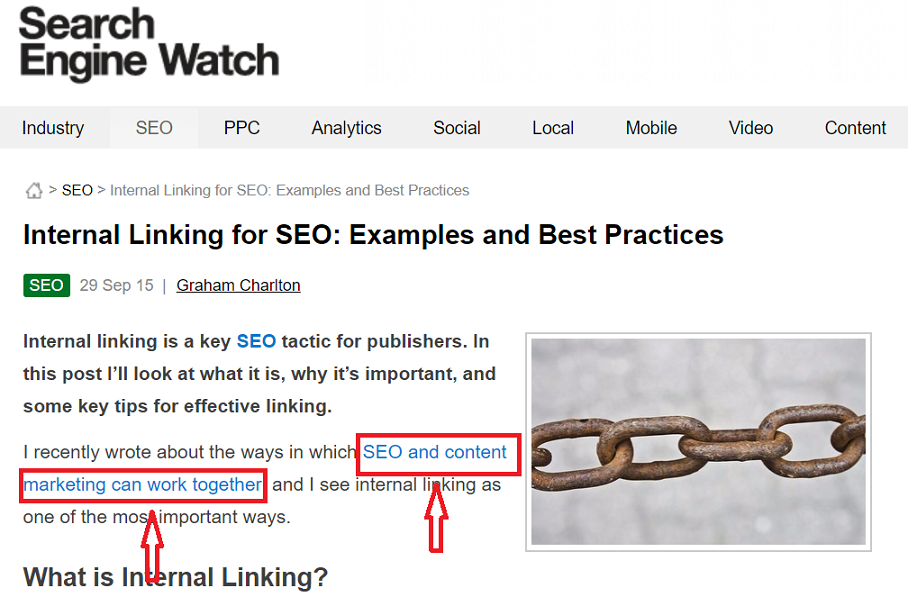
27. Backlinks
You can use a few different strategies to get backlinks from authority websites, like:
- Guest blogging – publishing your articles on high authority websites (and linking back to your website inside the guest post or within your author bio)
- News releases – releasing an expert positioning article in the format of a news release that quickly gets picked up by hundreds of websites with a high Google authority (like the local websites of the TV stations ABC, CBS, NBC and FOX and Google News). This is a great way to quickly get dozens of good quality backlinks. One of my clients has recently got 1029 backlinks in only 48 hours with this exact strategy, so I see a lot of potential here.
- Backlinks exchange with other bloggers.
C. How to increase blog (website) traffic through email marketing
28. Email marketing with CTA such as “share this”
One of the great things about having an email list is that you always have a group of people who, the more engaged they are, the more will help you spread the word on your new content.
29. Email marketing – autoresponder
If you don’t have a welcome email sequence in place, consider it. It is a great way to introduce yourself to new subscribers and start a great relationship with them, but it can also have a strategic impact on your traffic if you insert a few links to your best content.
30. Include a link to your blog in your email signature
Everyone you come in contact with should know that you have a blog and, depending on your email software, you can use a variety of tools to do this.
31. Roundup emails
Depending on how much content you produce, you can send out monthly/quarterly/yearly emails containing roundups of your best content.
D. How to increase blog (website) traffic by getting in front of other people’s audience
Especially when you are starting out, leveraging the audiences of more established platforms is an amazing way to get a traffic kick and gain email subscribers as well.
32. Guest posting/guest blogging
Online marketing gurus like Neil Patel and Ramit Sethi swear by guest blogging as a powerful traffic strategy. This means you write an article that you publish on an already established website and make yourself visible in front of their readers. I could talk about this topic all day long. If you want to learn more about how to write persuasive guest blogging pitches, you can read my article here.
33. Medium
You can write an article on Medium and then submit it to various publications that use Medium as a publishing platform. Once your article is accepted, you can get lots of traffic (depending on how many readers that specific publication has).
34. Be a guest on a podcast
If you are better at talking than writing, you will be happy to know that there are thousands of podcasts that are looking for a guest. Do your research and send your pitch.
35. Syndication
There are online platforms that accept publishing content that has been published somewhere else: Business2Community, LinkedIn, Medium, etc. You can also use paid tools like Outbrain to take your content syndication strategy one step further.
36. Use HARO
Create a free account on HARO (Help A Reporter Out), where lots of bloggers and journalists are looking for the best sources for their articles. Once you sign in you will get three emails per day with all the HARO queries (you can filter them by topic) and by replying to those that fit your expertise you can get featured on authority websites.
37. Use SourceBottle
SourceBottle is the Australian little brother of HARO, so it makes sense if you are targeting an audience based in Australia and New Zeeland.
38. Get on local TV/press/radio
Do your research and find out newspaper columns, radio shows and TV segments that are a great fit for your brand, business or story. Then find out the contact information of the editor/host/producer and send your pitch. Start locally and move your way up on the media ladder.
39. Be a speaker in a virtual summit
Virtual summits can do wonders for your traffic because they are gathering together a good number of experts that offer their advice and tips to the same audience. So the traffic potential is multiplied.
40. Apply for speaking gigs
There are lots of offline conferences and workshops organized in different niches. Find a list of events that are happening this year in your industry and send speaking inquiries. A shortcut would be to ask someone you know, who has been a speaker before, to introduce you to the organizers of a specific event. And don’t think that only big events are worthwhile: especially if you don’t have a lot of credentials and connections that can back you up, start with small events.
Here are a few Google search results that came up when I researched “speaking opportunities 2019 online marketing”:

41. Host a free workshop for other people’s communities
It will always be much easier to leverage an existing audience that to start one from scratch. Find people who are targeting the same audience as you do (but are not your direct competitors) and reach out. Chances are they are looking for quality free information to offer to their audience, so this will be a win-win situation.
42. Host a joint webinar
By hosting a joint webinar with another business, you are both leveraging each other’s audiences and marketing efforts (via a joint promotion strategy, thus splitting any costs involved).
43. YouTube video cross promotion
Record a value-packed YouTube video for someone who serves the same audience as you do, without being your direct competitor. Then return the favor.
44. Write about established people in your space and share the articles with them: case studies
It is always a great idea to write a valuable post about a specific strategy that an influencer has used to get from point A to point B. The more accurate and value-driven the article is, the more likely will be that the influencer will share the article with his/her huge audience.
45. Be part of a joint giveaway
Joint giveaways are a popular method to quickly increase an email list (and traffic). In a joint giveaway, several brands come together to offer something of value that will be part of the giveaway bundle (sometimes worth thousands of dollars). People are asked to perform a certain action (signing up, sharing the giveaway, following a social media page, etc) to participate in the giveaway and increase their chance of winning.
46. Write “quotes” based articles with quotes from 10 influential people in your space and share the post with them
Choose your topic the create a panel of experts that can share their tips/insights. Use social media or email to reach out to them and ask for their quote, then write and publish your article and share it with anyone who contributed. If the article is relevant, they will share it with their audiences.
47. Content curation
Curate a list of “best articles on [insert your topic]”, publish it on your website and then share it with everyone you included in your post.
48. News releases
You can write a journalistic style piece on different topics that position you as an expert (market predictions, sharing tips based on your experience, explaining what life lessons can be learned from a popular movie, sharing company updates etc.) and use a news release service to put it out there. In just a few days your story can get picked up by thousands of websites and blogs and you can use all these media logos as an authority element. I used this strategy many times for my clients and it works like a charm (when done the right way).
49. Interview someone and ask them to share
By interviewing someone who serves the same audience as you do (but in a different way), you are producing great value content for your audience while also reaching that other expert’s audience (once they share it).
50. Guest emailing – write a value-driven email that others can send to their lists
Email is a powerful nurturing and selling tool, and as part of the nurturing strategy, delivering awesome content emails to your subscribers is a must. Marketers send out regular emails for which they need to create the content so if you write the content for them you make their lives easier. The principle here is the same as with guest blogging: you write value-packed email content that another person sends to his/her email list, thus introducing you to them.
51. Become a regular contributor
Once you have published your first article on a popular platform in your space, it will be much easier to publish a second one. Use your new connection with the editor/blogger to propose another great article and then another. There are also platforms where, once your general author application has been approved, you can publish as many times as you want, like Business2Community. Other platforms charge a small fee to allow you to become a regular contributor, such as YourTango ( a great website in the personal development/relationships niche).
52. Connect with influencers
Reaching out to influencers and providing value to them will be extremely beneficial for your traffic (and business). Here you can listen to a great podcast episode with Selena Soo, a top media strategist (and one of my media mentors), on how to do this without looking desperate.
53. Be a star student
Online course creators are always on the lookout for new great case studies and testimonials they can use in their launches and showcase to thousands of people (together with your website).
A few examples: Bushra Azhar (love this woman!) from The Persuasion Revolution was featured as a stellar case study on Ramit Sethi’s website and Shamanth Pereira who achieved some great results when she launched Invisibelly landed a great feature in all the promo materials made by the guys at Foundr.
54. Share your results
Think about what products, services, tools you use and email those brands with your (stellar) results – this will make them look good in front of their audience, so they will be happy to share your story.
55. Ask fellow bloggers / online business owners
While running your blog or online business, we are always making new connections and friends from people like us, who are at the same business level as we are. I am sure lots of them will be more than happy to share your super valuable blog post (as you can see, almost everything centers around VALUE).
56. Add your blog to AllTop
AllTop publishes news from all niches. If you meet their requirements, you can submit your website, which means that your articles will be featured inside the AllTop category they best fit into.
57. Join Triberr
Triberr is a network of content creators that cross-promote their content. There are thousands of “tribes” grouped around a common topic (from the environment and pets to fitness and humor).
58. Add your blog to Blogarama
Blogarama is one of the oldest blog directories with millions of visitors. You can submit your blog for free and also get a premium version to get even more visitors.
59. Google News
If you meet specific requirements, you can submit your blog to Google News, which means great exposure for your website.
60. Platforms specific to one niche
There are platforms where you can submit your content and engage with other people in your space, in a specific niche — examples: GrowthHub for online marketers, GitHub for developers, ManageWP for WordPress geeks.
E. How to increase blog (website) traffic by leveraging the power of your website
61. Use an SEO friendly online publishing platform
I use WordPress, which makes it easy to publish SEO friendly content. For a more detailed comparison between several platforms, check out this article.
62. Use the right hosting
The most expensive hosting companies are not always the best ones and this will affect your website speed and even availability. Do your due diligence and look for the best options you can afford. Don’t be afraid to ask for other’s personal experiences with hosting; you can learn a lot of things. Two years ago, I switched from a big-name hosting company (with crappy customer service) to TMD Hosting and never looked back.
63. Keep it simple – remove any distractions
Set up one desired objective for each page on your website and then remove any potential distraction that can keep website visitors take the desired action (reading and sharing your blog posts, signing in, book a call with you, etc.) Also, if traffic increase is your primary objective, don’t allow third-party advertising on your website, as this can drive people away.
64. Improve speed
Surveys say that half of our website visitors tend to abandon a site that isn’t loaded within 3 seconds. So the speed of your website directly impacts your traffic (and sales).
65. Responsiveness
In 2018, for the first time, mobile traffic worldwide was bigger than desktop traffic, with regions like Asia witnessing even a whopping 60% mobile traffic. It makes it a no brainer that your website must be responsive (to look good when accessed via a mobile device). Luckily, most website platforms and theme offer this option at no extra cost.
66. List your most popular posts
On website platforms like WordPress, you have the option of displaying your most popular blog posts as a list on your home or blog page, making it easy for readers to go to those posts. Below you can see this tactic as applied by Marie Forleo:
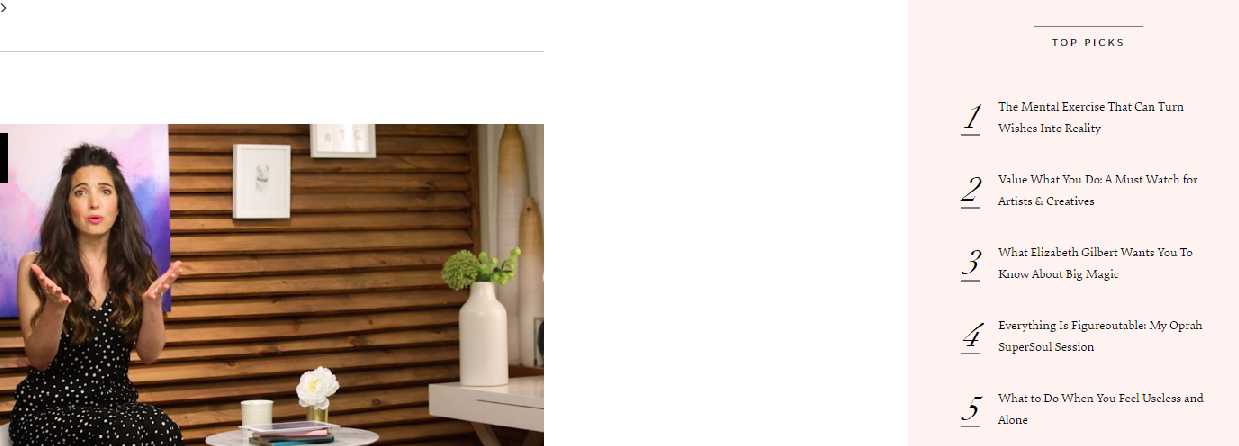
67. Social proof / Authority signs
Any authority signs (such as media logos, social media audience, email subscribers, number of clients served) should be displayed in prominent places on your website. If you are just starting out, using a great news release that is guaranteed to be picked up by major websites is a great shortcut to having a few great media logos to use (on top of doing wonders for your SEO).
F. How to increase blog (website) traffic through social media
68. Include a link to your website on all your social media profiles
Everyone who gets to any of your social media profiles should be able to immediately see that you have a website. Here are a few great examples:
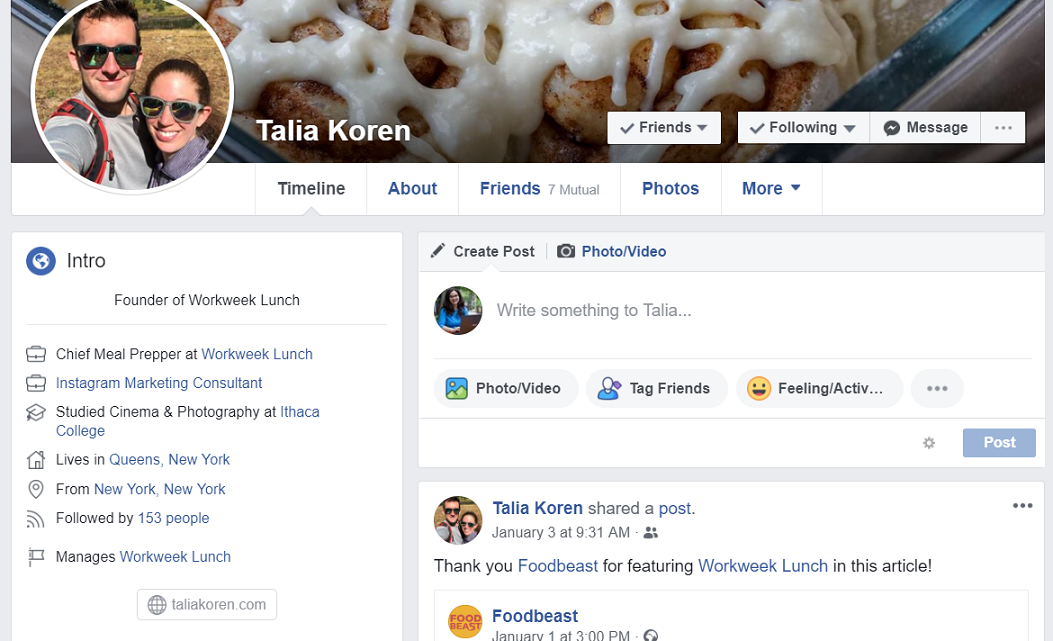
Facebook profile example – Talia Koren from https://workweeklunch.com/
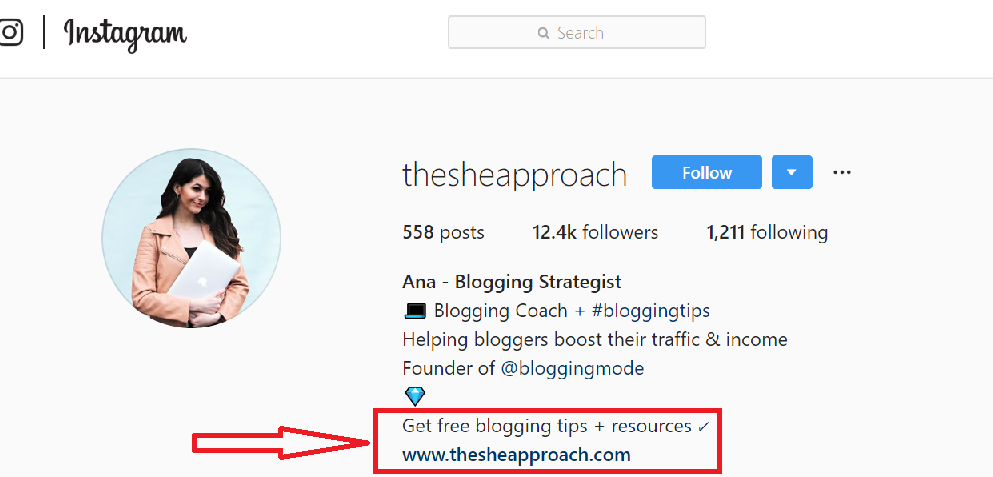
Instagram profile of https://thesheapproach.com
69. Share your content regularly on all the social media platforms you are on
You can use paid tools like Buffer or MeetEdgar to automate your content posting and make sure you have a consistent social media content strategy with minimal effort.
70. Start a Facebook group
In 2018 Facebook groups became more popular than Facebook pages, as they better foster connection with likeminded people. Half of the 3 billion active Facebook users check groups every month. By starting your group, you can build a community that will love reading and sharing your content that they find valuable, entertaining or motivating.
71. Join and be active in FB groups: powerful introduction, be helpful, watch the promo threads, search for threads on your topic
Facebook groups provide a place where members can connect based on a common interest and share their views, images, videos and much more. Here is a detailed article about how to find relevant groups for you and how to use them for blog traffic.
72. Ask your friends to share your content (via your personal FB profile)
This should be the first traffic strategy to use when you are just starting out. If 30 people share your new blog with their connections, you can get your first 1,000 readers in one day. Plus, you can never know who your blog post will reach, after today we are only a few connections away from anyone.
73. Start a Youtube channel
YouTube is the world’s second largest search engine and third most visited site after Google and Facebook. In 2018, as the Facebook ad cost increased, a lot of influencers in the online marketing space have started to focus more on their YouTube strategy (content and ads) and I predict that in 2019 this trend will continue, demonstrating once more that YouTube is a great platform to leverage for blog traffic.
74. Pinterest
Pinterest is another search engine that is often mistaken by a social media platform. Pinterest works like magic for blog traffic, as its users are there to look for information and consume content. 1 out of 2 millennials confirms using Pinterest every single day. And with 40% of its users making more than 100k/year, it makes it a no brainer to focus on a Pinterest strategy in 2019. Suzi Whitford from Startamomblog.com has put together an amazing post on how to use Pinterest for traffic in 2019.
75. LinkedIn – publish content
It is very easy to publish an article on LinkedIn and, if it gets traction, it can be featured on LinkedIn Pulse, which will get a lot of visibility. LinkedIn members have the most purchasing power compared to any other social media network.
76. LinkedIn groups
Participating in LinkedIn groups is a great way to establish your authority and get people back to your website.
77. Stand out on Instagram
Just having followers on Instagram will not help at all, you need to have an engaged audience. So for Instagram success, you need tasty content and here is a great resource on how to do just that: Instagram Success in 2019
78. Instagram shoutouts
Two brands can collaborate by agreeing to give each other a shoutout and post a photo or a video asking their followers to follow the other’s account. If your audience is on Instagram and you have a marketing budget you can even buy IG shoutouts from influencers. Pay attention when spending money, though, you will only get results if that audience is engaged.
79. IG – hashtags
It is well known that Instagram is all about using the right hashtags for you, that are also trending. There are lots of tools to find hashtags, but experts like Deepshikha Sairam from Socialique recommends, the best way is the old fashioned way: manually.
80. Twitter
I know Twitter is still a mysterious social media platform for a lot of businesses, so here are a few things to have in mind, according to Jeff Bulas:
- Just like with your blog posts, the headlines must be worth clicking on
- Use relevant hashtags for engagement increase
- Tweets with images get 150% more retweets
- You need to tweet frequently
81. Google+
On Google+ you can find communities, the equivalent of Facebook groups. Their topics range from photography to Harry Potter and business and some of them have up to 10 millions members, so they are definitely worth exploring.
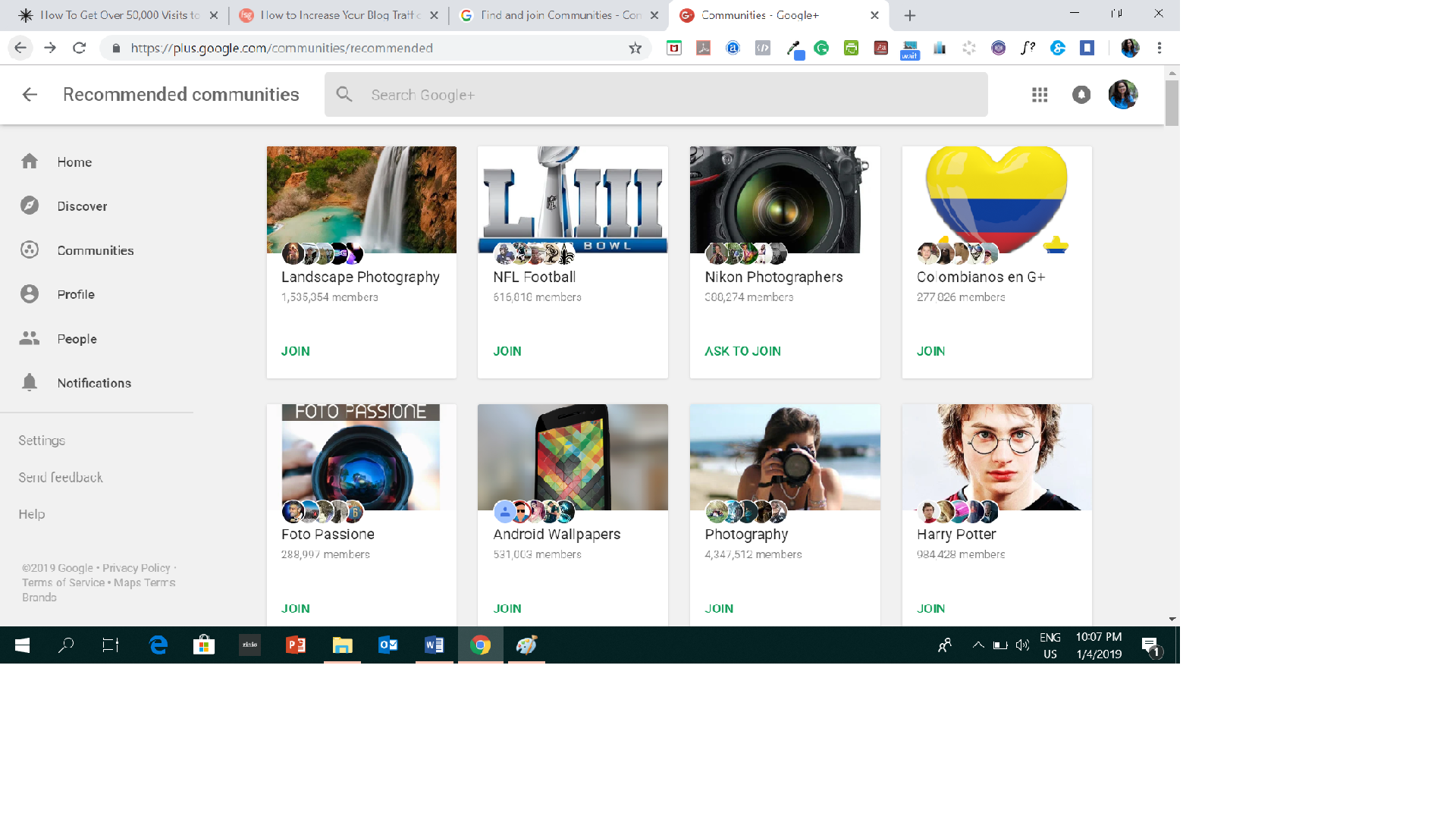
82. Slack
Started as a tool used for office communication, Slack has also become a way for people to connect, share content and ask for feedback. The group topics range from startup to gaming and Asia – see here a full list of Slack groups.
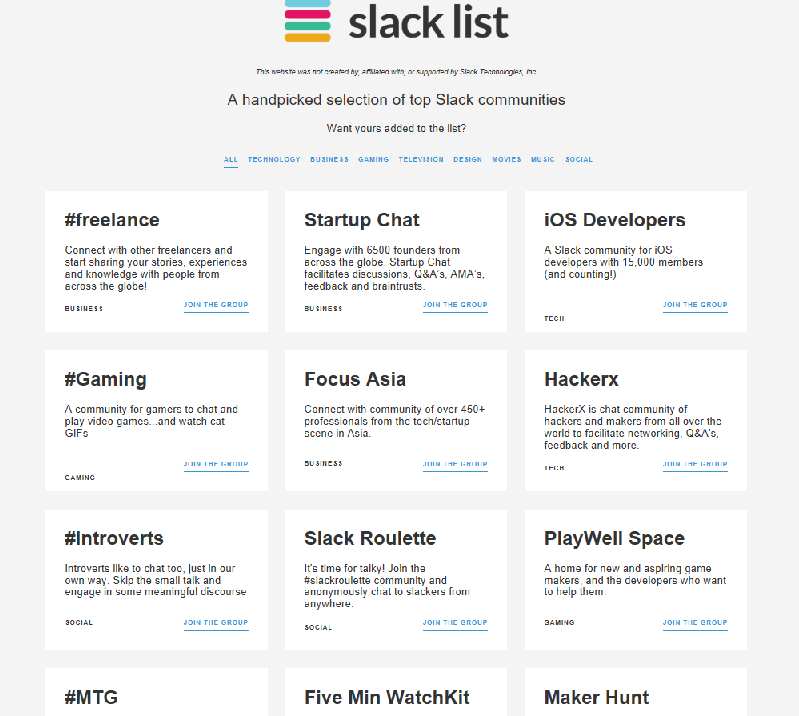
83. Other social media platforms
Because everyone’s attention is on the top 4 social media platforms (Facebook, Instagram, Twitter, LinkedIn – I excluded the search engines like Pinterest and YouTube), it is a great moment to tap into hidden gems where the competition for people’s attention is lower. Here you can find a list of 60 social media platforms that are worth exploring.
G. How to increase blog (website) traffic by generating buzz around your brand/business
84. Super valuable free lead magnets
If you have a lead magnet (or more) that are so good that people would pay for, your traffic strategy just got easier. People like to share super valuable things with their friends, it makes them look good, so once the word goes out about your free optin offer you can have lots of word of mouth referral. I wrote about how you can make a lead magnet convert at +60% in this article.
85. Host a free online course on your own platform
Put together a great online course on your topic and make it free then share it with everyone you know. You can even allow people to access it for free only after they share it. This is possible if you host your course on a platform like Teachable (they have a free plan)
86. Publish a free course on Udemy
Udemy is an online courses marketplace with more than 80,000 courses and 24 million students. A great traffic strategy is to publish a free course here and include links to your website for further resources.
87. Viral referral
You can host a giveaway, asking people to share your content if they want to have a chance of winning. A giveaway is a great traffic strategy, and you can make things simple by using tools like UpViral.
88. Q&A platforms
Platforms like Quora or StackExchange are a good way to build up your expert status while also going deep into the burning needs of your audience. Look for questions on your topic and answer them, providing as much value possible. You will also insert links to any content that you have on your website that is relevant. Here are a few topics of discussion on Quora:

89. Reddit
The Reddit platform may look a little bit outdated but don’t let this fool you. The community is very engaged, which makes is a great place to share your expertise. Like with any other community, observe the rules and keep away from spamming with your links. Focus on providing value and insert your links if it makes sense. There are many subreddits, and each of them has its own rules, so do your research.
90. Blogging communities
You can join blogging communities to network with like-minded people that support each other. Here is a nice list of 70 blogging communities you can check out: Mashable list of blogging communities
91. Comment on the articles published on the top websites in your niche
This will help you get on the radar of the influencers who published those articles, while also establishing your authority in front of the other readers. One of my clients, Seema, used this strategy and immediately landed a guest post on an authority blog because the blogger liked her value driven comment and invited her to expand on it via a guest post.
92. Attend conferences/networking events
I am talking about conferences on your topic but also conferences addressed at your ideal audience. While you are there, make sure you can tell any new connection in 10 seconds what you do and what is your website. You can also prepare business cards and include your website info.
Also, conferences are not only for marketing or business people; you can find at least a few ones in almost any niche. Just look at how many knitting conferences I found with a simple Google search:
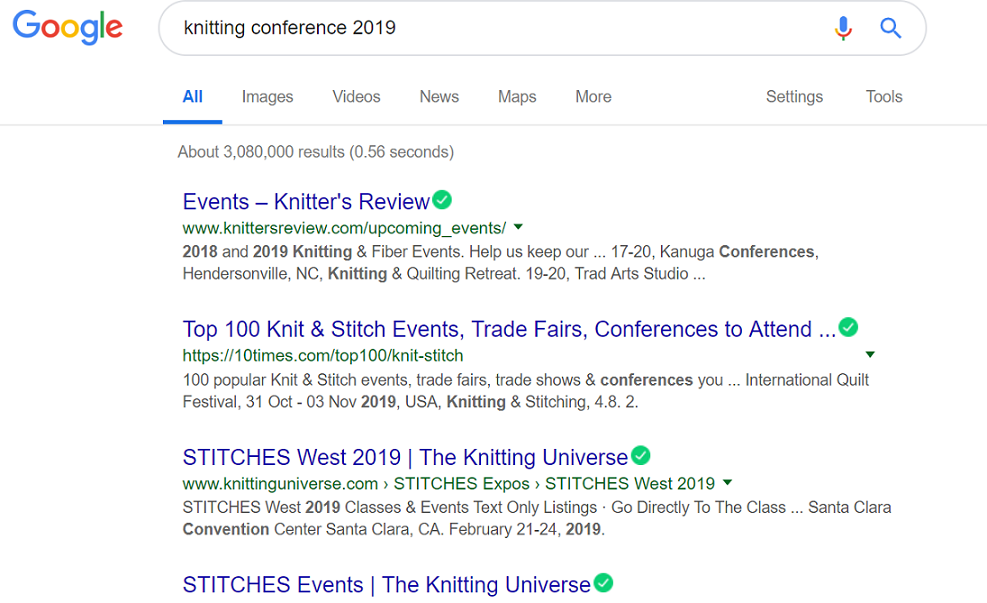
93. Organize your own offline event
Depending on your market, an offline event can be even more successful than an online one. You can host a free (or even low price) workshop or just a networking event which will give you the opportunity to make new connections and let people know about your website.
94. Be active in online communities in your space
Besides Facebook groups, there are also stand alone online communities that formed around specific topics and interests, like GrowthHackers and Inbound for marketers or DeviantArt for designers and StackOverflow for developers. Reddit also has lots of subgroups on various topics.
95. Start a Wikipedia page or submit content to other Wikipedia pages
You can create a page about a specific topic and include links to your articles as a source of information. If you are an expert in your topic (according to the Wikipedia rules) you can also submit your articles as Wikipedia resources.
96. Enter to win an industry award (or more)
Today you can find a lot of awards available for companies in many industries. Winning one of them is a great authority builder, and it can also get a lot of traffic to your website.
97. Launch something
Launches involve a good amount of work, but when done right, you can earn money while skyrocketing your traffic and email list. I wrote here about how to put together a launch strategy.
H. How to increase blog (website) traffic through paid traffic
98. Paid ads (on the social media platform that is relevant for your audience)
Yes, some ad costs have gone up in 2018. But this should not scare you, a LOT of the ads that I see today are sounding and looking all the same, which means you have an opportunity if you choose to do things differently. With the right testing, you can get great traffic even with a small budget. The only thing to get right is to be clear about what is the right ads platform for you, aka where your ideal audience hangs out.
For example: as 90% of Facebook ads are focused on promoting people to their lead magnet or even paid offer, your solution to stand out is to direct people just to your latest piece of content. I want to emphasize that this content needs to be highly valuable, not average in any way. This will increase your reach and your overall results while ensuring a low cost per click. At the end of the article, you should include a content upgrade as a way to also grow your email list (if your article is valuable, I bet people will love to sign in). Maybe you will not get as many sign-ups as with a traditional optin ad, but their quality will be better, and you will spend less money.
On the other hand, when you stop the ads, the traffic will also stop. So you want to use this strategy as a supplement of all the other organic traffic strategies.
99. Paid influencers promotion
If you want to get more traffic to a sales page and you carefully choose the influencers you want to collaborate with, this strategy can give you a nice return on investment. In this article on SocialMedia Examiner, Lilach Bullock has covered getting started with influencers marketing campaigns.
100. Paid media
There are lots of great websites that accept standard guest post submissions, while also offering the possibility of a promoted story. If you are a brand that is looking to get quick media coverage, you can pay to get your story published fast. A sponsored story usually gives you the opportunity to insert links to your product pages inside the article, which is not allowed in a “regular” submission.
I. Rinse and repeat
101. Analytics
As with any other business or marketing strategy, you need to measure your results and see what works best for you. For measuring your website traffic, Google Analytics is a great and easy to use tool. So install it on your website, track your best results and simply do more of that.
This is it! 101 great strategies to increase your website or blog traffic in 2019 (and beyond). You can also download the PDF version and save it on your computer for future reference, do this by inserting your info in the box below.




